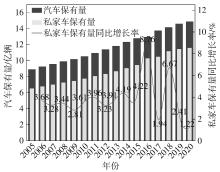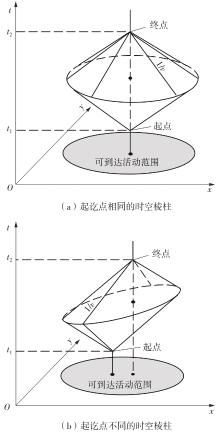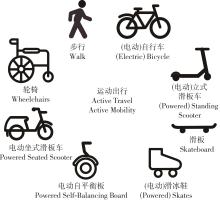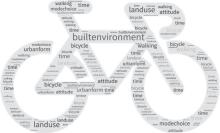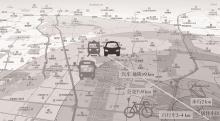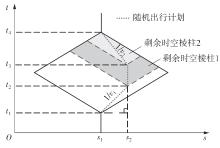华南理工大学学报(自然科学版) ›› 2024, Vol. 52 ›› Issue (2): 113-123.doi: 10.12141/j.issn.1000-565X.230228
时空约束对运动出行的影响
杨亚璪 翁唐政
- 重庆交通大学 交通运输学院,重庆 400074
-
收稿日期:2023-04-11出版日期:2024-02-25发布日期:2023-06-05 -
作者简介:杨亚璪(1981-),男,博士,副教授,主要从事交通运输规划与管理研究。E-mail:yyzjt@cqjtu.edu.cn -
基金资助:国家自然科学基金资助项目(61803057);教育部人文社科基金资助项目(17YJCZH220)
Impact of Spatiotemporal Constraints on Active Travel
YANG Yazao WENG Tangzheng
- School of Traffic & Transportation,Chongqing Jiaotong University,Chongqing 400074,China
-
Received:2023-04-11Online:2024-02-25Published:2023-06-05 -
About author:杨亚璪(1981-),男,博士,副教授,主要从事交通运输规划与管理研究。E-mail:yyzjt@cqjtu.edu.cn -
Supported by:the National Natural Science Foundation of China(61803057);the Humanities and Social Science Fund Project of the Ministry of Education(17YJCZH220)
摘要:
运动出行(Active Travel或Active Mobility,AT或AM)是一种以出行者自我为驱动的出行方式,由于其占用道路面积小、机动性强、可持续性好,因此对缓解城市交通压力、改善城市交通的时空不合理性起着至关重要的作用。文中首先研究了运动出行的定义和内涵;其次从影响运动出行的时空条件出发,以点和线的视角将时间与空间拆分成出发时间、出行时间、出行距离与建成环境4类约束条件,依次阐述不同类型的时空条件特征,并对运动出行与时空约束间的潜在联系进行分析;接着以单一约束和多种时空组合作为切入点,分析其对运动出行的影响;通过归纳发现,时空约束对运动出行的影响比传统认知中更为复杂,主要呈非线性关系且存在相应的理论阈值;最后提出当前理论研究中的不足之处及未来的研究方向。文章旨在归纳时空对运动出行的制约作用,展示不同时空约束作用下运动出行的具体变化规律,以期改变城市出行者的固有思维,提高运动出行的分担率,促进城市交通出行结构的进一步优化。
中图分类号:
引用本文
杨亚璪, 翁唐政. 时空约束对运动出行的影响[J]. 华南理工大学学报(自然科学版), 2024, 52(2): 113-123.
YANG Yazao, WENG Tangzheng. Impact of Spatiotemporal Constraints on Active Travel[J]. Journal of South China University of Technology(Natural Science Edition), 2024, 52(2): 113-123.
表1
基于效用与前景理论的出发时间决策模型"
| 理论 | 模型 | 备选方式 | 城市 | 调查方法 | 文献 |
|---|---|---|---|---|---|
| 效用理论 | 二项 Logit模型 | 私家车、 公共交通 | 武汉 | RP调查、 实地访谈 | [ |
交叉巢式 Logit模型 | 私家车、公共交通、自行车、步行 | 北京 | RP调查 | [ | |
| 离散-连续模型 | 私家车、公共交通、自行车、 步行、其他交通 | 多伦多 | 抽样调查、 旅行日记 | [ | |
| 前景理论 | 分段函数 | 私家车 | 台中 | 电话访谈 | [ |
| 动态流量分配模型 | 私家车(燃油、 电动)、公共交通 | 实地实验 | [ | ||
混合 Logit模型 | 私家车、地铁、 公交车 | 上海 | 实地访谈、 SP调查 | [ | |
| 效用理论 + 前景理论 | 自建模型 | 私家车、地铁、 公交车 | 北京 | 仿真实验 | [ |
| 基于前景理论构建的 模型 | 私家车、 公共交通 | 西安 | 仿真实验 | [ |
表2
不同城市的距离区间划分标准"
| 国家/城市 | 备选方式 | 区间距离划分 | 文献 |
|---|---|---|---|
| 中国/北京 | 私家车、公共交通、 自行车、步行 | 短距离:<5 km | [ |
| 私家车、公交车、 地铁、共享/私人单车、步行 | 短距离:<5 km 中长距离:5~9 km | [ | |
| 印度/特里凡特朗 | 私家车、公交车、 出租车、电动三轮车、摩托车 | 短距离:0~5 km 中距离:5~10 km 长距离:11~20 km | [ |
| 瑞士/苏黎世 | 私家车、公共交通、 (电动)自行车、 步行、电动滑板车 | 短距离:<3 km | [ |
| 中国/西安 | 私家车、公交车、 轨道交通、步行、 非机动车 | 短距离:<8 km 中距离:8~15 km 长距离:>15 km | [ |
| 中国/太原 | 私家车、公交车、 电动自行车、 共享单车 | 短距离:<2 km 中距离:2~5 km 长距离:>5 km | [ |
| 1 | SCHRANK D, EISELE B, LOMAX T,et al .2015 Urban mobility scorecard[R].Texas:Texas A&M Transportation,2015. |
| 2 | MACKETT R L .How to reduce the number of short trips by car[C]∥ Proceedings of the Seminar C of the European Transport Conference.Cambridge:PTRC-Publications-P,2000:87-98. |
| 3 | JOKUBAUSKAITE S, HOSSINGER R, ASCHAUER F,et al .Advanced continuous-discrete model for joint time-use expenditure and mode choice estimation[J].Transportation Research Part B:Methodological,2019,129:397-421. |
| 4 | NEVES A, BRAND C .Assessing the potential for carbon emissions savings from replacing short car trips with walking and cycling using a mixed GPS-travel diary approach[J].Transportation Research Part A:Policy and Practice,2019,123:130-146. |
| 5 | ZHOU X, YU Z, YUAN L,et al .Measuring accessibility of healthcare facilities for populations with multiple transportation modes considering residential transportation mode choice[J].International Journal of Geo-Information,2020,9(6):394/1-25. |
| 6 | HÄGERSTRAND T .What about people in regional science[J].Regional Science Association,1970,24:7-21. |
| 7 | MILLER H J .Modelling accessibility using space-time prism concepts within geographical information systems[J].International Journal of Geographical Information System,1991,5(3):287-301. |
| 8 | RAUBAL M, MILLER H J, BRIDWELL S .User-centred time geography for location‐based services[J].Geografiska Annaler:Series B,Human Geography,2004,86(4):245-265. |
| 9 | ZHAO S D, ZHANG K L .Observing individual dynamic choices of activity chains from location-based crowdsourced data[J].Transportation Research Part C:Emerging Technologies,2017,85:1-22. |
| 10 | 王健 .人类出行的第四次革命[J].经营者(汽车商业评论),2022,657(9):344-371. |
| WANG Jian. The fourth revolution of human mobility[J].Operator (Auto Business Review),2022,657(9):344-371. | |
| 11 | COSTA J, ADAMAKIS M, O’BRIEN W,et al .A scoping review of children and adolescents’ active travel in Ireland[J].International Journal of Environmental Research and Public Health,2020,17(6):2016/1-19. |
| 12 | ALATTAR M A, COTTRILL C, BEECROFT M .Sources and applications of emerging active travel data:a review of the Iiterature[J].Sustainability,2021,13(13):7006/1-17. |
| 13 | SHAKEEL K, RASHIDI T H .Incorporating active and non-active mode preferences for departure time choice behavior[J].Transportation Letters:the International Journal of Transportation Research,2022,14(7):697-709. |
| 14 | 宋彦李青,王竹影 .城市老年人活动——出行行为特征及相关建成环境影响研究[J].西南交通大学学报(社会科学版),2018,19(6):77-89. |
| SONG Yan li-qing, WANG Zhu-ying .Study on the characteristics of activity-travel behavior of urban elderly and the impact of related built environment[J].Journal of Southwest Jiaotong University (Social Sciences),2018,19(6):77-89. | |
| 15 | HATAMZADEH Y, HABIBIAN M, KHODAII A .Walking behaviors by trip purposes[J].Transportation Research Record,2014,2464(1):118-125. |
| 16 | SENER I N, REEDER P R .An integrated analysis of workers’ physically active activity and active travel choice behavior[J].Transportation Research Part A:Policy and Practice,2014,67:381-393. |
| 17 | 郭士永,李文权,陈茜,等 .公交动态信息下通勤出发时间选择行为分析[J].交通信息与安全,2014,32(3):12-17. |
| GUO Shiyong, LI Wenquan, CHEN Qian,et al .Analysis of the choice behavior of commuting departure time under the dynamic transit information[J].Journal of Transport Information and Safety,2014,32(3):12-17. | |
| 18 | 吴苏萍,田丽君,方云飞 .基于活动效用的通勤者出行方式选择研究[J].系统科学与数学,2020,40(10):1737-1748. |
| WU Suping, TIAN Lijun, FANG Yunfei .Study on the travel mode choice of commuters in an activity-based model[J].Journal of Systems Science and Mathematical Sciences,2020,40(10):1737-1748. | |
| 19 | LI M, SONG G H, CHENG Y,et al .Identification of prior factors influencing the mode choice of short distance travel[J].Discrete Dynamics in Nature and Society,2015,2015:1-9. |
| 20 | JOU R C, KITAMURA R, WENG M C,et al .Dynamic commuter departure time choice under uncertainty[J].Transportation Research Part A:Policy and Practice,2008,42(5):774-783. |
| 21 | 宗刚,曾庆华,魏素豪 .基于时间价值的交通出行方式选择行为研究[J].管理工程学报,2020,34(3):142-150. |
| ZONG Gang, ZENG Qinghua, WEI Suhao .Research on traffic mode choice behavior based on commuting travel time value[J].Journal of Industrial Engineering and Engineering Management,2020,34(3):142-150. | |
| 22 | 张介诚 .居民出行时间与出行方式的联合选择研究[J].交通与运输,2020,33(S2):24-28. |
| ZHANG Jiecheng .Research on the joint choice of residents’ travel time and travel mode[J].Traffic & Transportation,2020,33(S2):24-28. | |
| 23 | 杨励雅,李娟 .居民出行链、出行方式与出发时间联合选择的交叉巢式Logit模型[J].北京大学学报(自然科学版),2017,53(4):722-730. |
| YANG Liya, LI Juan .Cross-nested Logit model for the joint choice of residential location,travel mode,and departure time[J].Acta Scientiarum Naturalium Univesitatis Pekinensis,2017,53(4):722-730. | |
| 24 | HABIB K M N .A joint discrete-continuous model considering budget constraint for the continuous part:application in joint mode and departure time choice modelling[J].Transportmetrica A:Transport Science,2013,9(2):149-177. |
| 25 | YANG J, WU F Z, YAN J,et al .Charging demand analysis framework for electric vehicles considering the bounded rationality behavior of users[J].International Journal of Electrical Power & Energy Systems,2020,119:105952/1-16. |
| 26 | GAO K, SUN L J, YANG Y,et al .Cumulative prospect theory coupled with multi-attribute decision making for modeling travel behavior[J].Transportation Research Part A:Policy and Practice,2021,148:1-21. |
| 27 | SUN R, LI M, WU Q .Research on commuting travel mode choice of car owners considering return trip containing activities[J].Sustainability,2018,10(10):3494/1-12. |
| 28 | HOSSINGER R, ASCHAUER F, JARA-DIAZ S,et al .A joint time-assignment and expenditure-allocation model:value of leisure and value of time assigned to travel for specific population segments[J].Transportation,2020,47(3):1439-1475. |
| 29 | 高坤,涂辉招,李浩,等 .出行者对不同交通方式行程时间可靠度和车内拥挤度的感知差异性[J].中国公路学报,2017,30(7):126-133. |
| GAO Kun, TU Hui-zhao, LI Hao,et al .Traveler’ perception differences in travel time reliability and crowding of mode-choice in multimodal networks[J].China Journal of Highway and Transport,2017,30(7):126-133. | |
| 30 | SIMS D, MATTHEWS S A, BOPP M J,et al .Predicting discordance between perceived and estimated walk and bike times among university faculty,staff,and students[J].Transportmetrica A:Transport Science,2018,14(8):691-705. |
| 31 | RAMEZANI S, LAATIKAINEN T, HASANZADEH K,et al .Shopping trip mode choice of older adults:an application of activity space and hybrid choice models in understanding the effects of built environment and personal goals[J].Transportation,2021,48(2):505-536. |
| 32 | LADES L K, KELLY A, KELLEHER L .Why is active travel more satisfying than motorized travel?Evidence from Dublin[J].Transportation Research Part A:Policy and Practice,2020,136:318-333. |
| 33 | ASHALATHA R, MANJU V S, ZACHARIA A B .Mode choice behavior of commuters in Thiruvananthapuram city[J].Journal of Transportation Engineering,2013,139(5):494-502. |
| 34 | BAGHERI M, MLADENOVIC M N, KOSONEN I,et al .Analysis of potential shift to low-carbon urban travel modes:a computational framework based on high-resolution smartphone data[J].Sustainability,2020,12(15):5901/1-24. |
| 35 | 姚恩建,李翠萍,郇宁,等 .共享单车对通勤走廊出行结构的影响[J].华南理工大学学报(自然科学版),2020,48(7):85-92,142. |
| YAO Enjian, LI Cuiping, HAO Ning,et al .Impact of shared bicycles on the configuration of travel mode in commuting corridor[J].Journal of South China University of Technology (Natural Science Edition),2020,48(7):85-92,142. | |
| 36 | RECK D J, MARTIN H, AXHAUSEN K W .Mode choice,substitution patterns and environmental impacts of shared and personal micro-mobility[J].Transportation Research Part D:Transport and Environment,2022,102:103134/1-18. |
| 37 | 牛凯,罗瑞琪,齐庆祥 .基于出行全过程的居民出行模式分析[J].交通与运输,2021,37(5):18-23. |
| NIU Kai, LUO Ruiqi, QI Qingxiang .Residents’ travel mode analysis based on the whole travel process[J].Traffic & Transportation,2021,37(5):18-23. | |
| 38 | LI W B, KAMARGIANNI M .Steering short-term demand for car-sharing:a mode choice and policy impact analysis by trip distance[J].Transportation,2020,47(5):2233-2265. |
| 39 | 曾思萌,叶茂,刘英舜,等 .共享单车引入后通勤者出行方式选择影响因素建模[J].交通信息与安全,2019,37(1):104-112. |
| ZENG Simeng, YE Mao, LIU Yingshun,et al .A model of influencing factors of travel mode selection for commuters with bike-sharing[J].Journal of Transport Information and Safety,2019,37(1):104-112. | |
| 40 | 李敏迪 .车辆供给和距离效应对公共自行车借车行为影响[J].公路交通科技,2017,34(2):121-128. |
| LI Min-di .Effect of bike supply and distance effect on behavior borrowing public bikes[J].Journal of Highway and Transportation Research and Development,2017,34(2):121-128. | |
| 41 | HE M W, PU L J, LIU Y,et al .Research on nonlinear associations and interactions for short-distance travel mode choice of car users[J].Journal of Advanced Transportation,2022,2022:1-15. |
| 42 | SAIYAD G, SRIVASTAVA M, RATHWA D .Assessment of transit accessibility through feeder modes and its influence on feeder mode choice behavior[J].Arabian Journal for Science and Engineering,2022,47(4):4483-4497. |
| 43 | 尹超英,邵春福,王晓全 .土地利用混合度对出行方式选择的影响[J].北京工业大学学报,2018,44(9):1227-1232. |
| YIN Chaoying, SHAO Chunfu, WANG Xiaoquan .Influence of land use mixture on travel mode choice[J].Journal of Beijing University of Technology,2018,44(9):1227-1232. | |
| 44 | WANG C H, CHEN N, TIAN G .Do accessibility and clustering affect active travel behavior in Salt Lake City?[J].Transportation Research Part D:Transport and Environment,2021,90:102655/1-11. |
| 45 | HABIB K N, HAN X, LIN W H .Joint modelling of propensity and distance for walking-trip generation[J].Transportmetrica A:Transport Science,2014,10(5):420-436. |
| 46 | YANG Y C, MCANDREWS C .Statewide analysis of individuals’ exposure to business establishments and active travel behavior[J].Transportation Research Record,2020,2674(4):101-113. |
| 47 | LIU S, YAMAMOTO T, YAO E .Joint modeling of mode choice and travel distance with intra-household interactions[J].Transportation,2023,50(5):1527-1552. |
| 48 | CHENG J, YAN R Y, GAO Y E .Exploring spatial heterogeneity in accessibility and transit mode choice[J].Transportation Research Part D:Transport and Environment,2020,87(2):102521/1-10. |
| 49 | ERMAGUN A, SAMIMI A, RASHIDI T H .How far is too far?Providing safe and comfortable walking environments[J].Transportation Research Record,2016,2586(1):72-82. |
| 50 | 尹超英,邵春福,王晓全,等 .基于改进熵的土地利用混合度对非通勤行为的影响[J].北京交通大学学报,2018,42(4):92-97. |
| YIN Chaoying, SHAO Chunfu, WANG Xiaoquan,et al .Influence of land use mix on non-work travel behavior based on modified entropy index[J].Journal of Beijing Jiaotong University,2018,42(4):92-97. | |
| 51 | DING C, WANG Y, XIE B,et al .Understanding the role of built environment in reducing vehicle miles traveled accounting for spatial heterogeneity[J].Sustainability,2014,6(2):589-601. |
| 52 | 董小楠,闫章存,赵怀明,等 .基于时空约束的出行方式选择行为分析[J].公路交通科技,2020,37(9):104-112. |
| DONG Xiao-nan, YAN Zhang-cun, ZHAO Huai-ming,et al .Analysis of travel mode choice behavior based on spatial-temporal constraint[J].Journal of Highway and Transportation Research and Development,2020,37(9):104-112. | |
| 53 | LI X F, ZHANG Y, DU M Y .Analysis of travel decision-making for urban elderly healthcare activities under temporal and spatial constraints[J].Sustainability,2018,10(5):1560/1-15. |
| 54 | SCHNEIDER F, DAAMEN W, HOOGENDOORN S .Trip chaining of bicycle and car commuters:an empirical analysis of detours to secondary activities[J].Transportmetrica A:Transport Science,2022,18(3):855-878. |
| 55 | LIU Y, JI Y J, LIU Q Y,et al .Investigating electric bicycles as a travel mode choice for escorting children to school a case study in Kunming,China[J].Transportation Research Record,2017,2634(1):8-16. |
| 56 | JI Y J, LIU Y, LIU Q Y,et al .How household roles influence individuals’ travel mode choice under intra-household interactions?[J].KSCE Journal of Civil Engineering,2018,22(11):4635-4644. |
| [1] | 庄焱, 董春娇, 米雪玉, 等. 基于改进网络核密度和负二项回归的事故黑点鉴别[J]. 华南理工大学学报(自然科学版), 2024, 52(1): 119-126. |
| [2] | 赵小梅, 郝郭宇, 牛晓婧, 等. 不同降雨量下基于宏观基本图的边界控制策略[J]. 华南理工大学学报(自然科学版), 2024, 52(1): 72-82. |
| [3] | 陈小鸿, 田田甜, 张华. 城市居民活动韧性——新冠肺炎疫情期间轨道客流恢复的实证[J]. 华南理工大学学报(自然科学版), 2023, 51(7): 109-119. |
| [4] | 胡兴华, 陈兴辉, 汪然, 等. 随机特性下考虑碳排放的公交优先控制优化模型[J]. 华南理工大学学报(自然科学版), 2023, 51(10): 160-170. |
| [5] | 许伦辉, 余佳芯, 裴明阳, 等. 基于几何路网结构和强化学习的车辆重定位策略[J]. 华南理工大学学报(自然科学版), 2023, 51(10): 99-109. |
| [6] | 沈羽桐, 李明, 崔志勇, 等. 混合服务模式车辆资源多时段分配方法研究[J]. 华南理工大学学报(自然科学版), 2023, 51(10): 89-98. |
| [7] | 王昊, 谢凝. 考虑有轨电车效率的干线分段绿波协调优化模型[J]. 华南理工大学学报(自然科学版), 2023, 51(1): 95-105. |
| [8] | 赵建东, 朱丹, 刘佳欣. 基于时间序列分解与门控循环单元的地铁换乘客流预测 [J]. 华南理工大学学报(自然科学版), 2022, 50(5): 22-31. |
| [9] | 吴娇蓉 谢金宏 王宇沁. 公交线路运行不稳定性画像方法及其应用[J]. 华南理工大学学报(自然科学版), 2022, 50(2): 15-22. |
| [10] | 陈小红, 胡芳. 基于可能度的交叉口信号控制区间优化模型[J]. 华南理工大学学报(自然科学版), 2022, 50(10): 29-40. |
| [11] | 俞礼军. 具有路段容量限制的广义系统最优交通分配[J]. 华南理工大学学报(自然科学版), 2021, 49(4): 140-148. |
| [12] | 姚恩建 卢沐阳 刘宇环 元凌. 考虑充电约束的电动公交区域行车计划编制[J]. 华南理工大学学报(自然科学版), 2019, 47(9): 68-73. |
| [13] | 刘仲波 赵小辉. 基于状态判别的环形交叉口信号设置依据[J]. 华南理工大学学报(自然科学版), 2018, 46(9): 92-98. |
| [14] | 陈小红 张协奎 陈诗淼. 信号交叉口周期时长区间决策模型 [J]. 华南理工大学学报(自然科学版), 2018, 46(4): 44-50. |
| [15] | 田晟 许凯. 考虑异质出行者的拥挤收费路网流量演化模型[J]. 华南理工大学学报(自然科学版), 2018, 46(11): 110-116. |
| 阅读次数 | ||||||
|
全文 |
|
|||||
|
摘要 |
|
|||||
